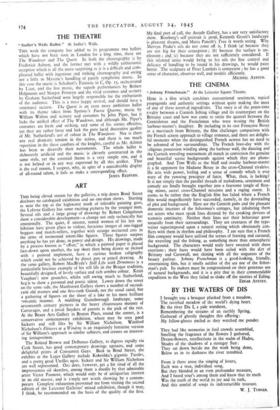ART
THIS being closed season for the galleries, a trip down Bond Street discloses no catalogued exhibition and no one-man shows. Starting as near the top as the highwater mark of tolerable painting goes, the Lefevre Gallery has some exciting pictures by the younger men. Several oils and a large group of drawings by Robert Colquhoun show a considerable development—a change not only technically but emotionally. The quiet, if sinister, seated women of his last ex- hibition have given place to violent, ferocious images of one-legged beggars and match-sellers, together with strange nocturnal cats in the arms of tormented totem-like figures. These figures surpass anything he has yet done, in power and design. His drawings, made by a process known as " offset," in which a painted paper is placed face-down upon another, the top sheet then being drawn or incised with a pointed implement, have a curious broken caligraphy which could not be achieved by direct pen or pencil drawing. At the same gallery, Robert MacBryde's Still Life with Dominoes is a particularly luscious example of his still life in the Braque tradition, beautifully designed, of lovely surface and rich sombre colour. Keith Vaughan's new gouaches, whilst still owing much to Sutherland, beg:n to show a personal and poetic talent. Lower down the street on the same side, the Matthiesen Gallery shows a number of second- rank old masters and one first-rank*Guardi, not the usual canal, but a gathering of figures on the shore of a lake in his most brilliant romantic manner. A middling Gainsborough landscape, some seventeenth century pictures in the heavy chiaroscuro manner of Carravagio, and a jovial Snyders of parrots is the pick of the rest. At the Beaux Arts Gallery in Bruton Place, round the corner, is a conservative contemporary exhibition, where may be seen good Sickerts and still lifes by Sir William Nicholson. Winifred Nicholson's Flowers at a Window is an exquisitely feminine version of Sir William's approach to similar subjects, and creates an interest- ing juxtaposition.
The Roland Browse and Delbanco Gallery, to digress rapidly via Cork Street, has good contemporary drawings upstairs, and some delightful prints of Constantin Guys. Back in Bond Street, the exhibits at the Leger Gallery include Kokoshka's gigantic Turtles, and a pretty good Utrillo; agair. Sickert and Sir William Nicholson are well represented. One does, however, get a bit tired of all the impressionist oil sketches, among them a doodle by that admirable artist Victor Pasmore, which would only be of antiquarian interest in an old master, and is simply not worth showing by a contem- porary. Complete exhaustion prevented me from visiting the second edition of the Leicester Galleries' mixed exhibition, though it may, I think, be recommended on the basis of the quality of the first. My final port of call, the Arcade Gallery, has a not very satisfactory show. Bomberg's self-portrait is good, Kenneth Green's landscape is pleasant theatre, and Maria Paneth's Tree it worth seeing. Why Mervyn Peake's oils do not come off is, I think (a) because they are too big for their conception ; (b) because the surface is un- pleasant ; and (c) because they are not sufficiently considered. If this talented artist would bring to his oils the fine control and delicacy of handling to be found in his drawings, he would paint better. The sculpture of Peter Lambda is competent ; he has a good sense of character, observes well, and models efficiently.
MICHAEL AYRTON.






















 Previous page
Previous page